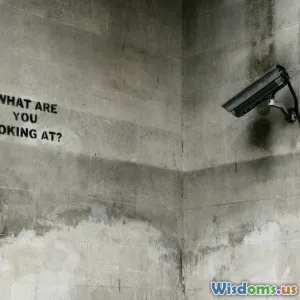
Why Do Crime Rates Fluctuate With Urbanization Surprising Data Revealed
9 min read Explore the complex relationship between urbanization and crime rates through surprising data insights and the socio-economic factors driving their fluctuations. (0 Reviews)
Why Do Crime Rates Fluctuate With Urbanization? Surprising Data Revealed
Urbanization has transformed human society dramatically over the past two centuries—from rural villages blossoming into sprawling megacities to new social dynamics emerging along the way. Yet a fascinating and complex challenge arises from this shift: crime rates linked to increasingly urban populations do not follow a straightforward pattern. Instead, they fluctuate in surprising and counterintuitive ways depending on a host of economic, social, and structural conditions.
In this article, we unravel the nuanced reasons behind the ebb and flow of crime rates amid urban growth, supported by empirical data and real-world examples. By debunking myths and digging into unexpected trends, we provide an insightful look into how urbanization shapes criminal activity.
Understanding the Basics: Urbanization and Crime Trends
Urbanization refers to the movement of people from rural to urban areas, typically transforming economies and lifestyles through increased population density, infrastructure, and diversity. Since the Industrial Revolution, the world's urban population has surged; as of 2023, over 56% of humanity lives in cities—a figure expected to exceed 68% by 2050 (United Nations, 2019).
Common assumptions often paint urban areas as hubs of persistent crime due to anonymity, economic disparities, and social fragmentation. However, academic research reveals that crime rates per capita don’t always rise monotonically with urban growth—in fact, certain stages of urbanization may coincide with decreases or shifts in crime types.
The Surprising Fluctuations: Empirical Data Insights
Non-linear Crime Patterns as Cities Grow
A study conducted by researchers at the University of Chicago (2018) analyzed crime data across several U.S. metropolitan areas spanning 20 years. They found that while violent crimes often spike during early urban growth phases—characterized by rapid migration and socioeconomic upheaval—rates often stabilize or even decline as cities mature and invest in social infrastructure.
Similarly, the Global Urban Crime Report (2021) highlights that rapidly urbanizing cities in developing countries like Lagos and Dhaka show elevated property crimes initially. Still, with improved governance and community programs, these examples demonstrate decreasing crime trends despite continued population increases.
Case Study: New York City - A Crime Decline Amid Growth
New York City’s history provides a compelling example of fluctuating crime amidst urbanization. In the 1970s and ’80s, NYC was notorious for high crime rates linked to socioeconomic issues and urban decay. In contrast, as the city invested heavily in policing technologies, economic revitalization, and urban renewal during the 1990s and 2000s, crime declined by nearly 75% despite a growing population, urban density, and economic expansion (FBI 2020 Report).
This paradox challenges simplistic narratives: a larger city need not equal more crime indefinitely.
Key Factors Driving Crime Fluctuations with Urbanization
Economic Inequality and Employment Opportunities
One of the most significant underlying influences is economic inequality. Urbanization often concentrates wealth disparity visibly, leading to socio-economic tensions.
Research indicates that when urbanization correlates with job creation, better education access, and upward mobility, crime rates tend to decrease. Conversely, underemployment and informal economies prevalent during rapid unplanned expansions foster environments conducive to crime.
For example, in Johannesburg, South Africa, informal settlement growth and insufficient policing led to spikes in violent crime during the 1990s, while subsequent economic and community investments moderated those rates gradually.
Social Cohesion and Community Structures
Urbanization leads to more diverse, heterogeneous populations, which can dilute traditional community bonds. Social disorganization theory posits that strong community institutions and networks act as protective factors against crime.
In Japanese cities like Tokyo and Osaka, where urbanization occurred alongside deliberate preservation of community ties and mixed-use neighborhoods, crime rates remain relatively low compared to cities with weaker social cohesion.
Urban Planning and Environmental Design
The physical layout of urban environments plays a critical role. Concepts like "Crime Prevention Through Environmental Design" (CPTED) emphasize how lighting, visibility, and public spaces impact crime opportunities.
Singapore exemplifies the success of meticulous urban planning—well-lit streets, communal areas, and effective public transportation coincide with its remarkably low urban crime rates, despite being a dense city-state.
Law Enforcement and Policy Implementation
Effective and equitable law enforcement initiatives directly influence crime trends. The "broken windows" policing approach implemented in NYC clamped down on minor disorder and incivilities to prevent larger crimes.
However, data shows that policies must be balanced; over-policing in marginalized communities can erode trust and provoke crime in the long term. Cities like Amsterdam adopt a community-centered policing model yielding positive longsterm crime reductions alongside urban growth.
Unpacking the Types of Crimes Influenced by Urbanization
Not all crime fluctuates in the same way with urban changes.
- Property Crimes: These often rise with sudden increases in urban poverty or informal settlements but decline with better housing and surveillance.
- Violent Crimes: More sensitive to economic shocks and social tensions, violent crime spikes in turbulent rapid expansion phases but can reduce when social services improve.
- Cybercrime and White-Collar Crime: With urbanization tied to greater digital and financial activity, such crimes tend to increase quietly even as traditional crime decreases.
Recommendations for Mitigating Urban Crime amidst Growth
- Balanced Socioeconomic Development: Create jobs and education opportunities that uplift vulnerable residents.
- Community Engagement: Support local neighborhood groups to maintain social cohesion.
- Urban Design Innovations: Implement CPTED principles for safer cities.
- Adaptive Policing Strategies: Use data-driven and community-centric law enforcement.
- Technology and Data Utilization: Smart city technologies can identify and predict crime hotspots.
Conclusion: Rethinking Crime and Urbanization
The relationship between crime rates and urbanization is neither linear nor universally applicable—rather, it's a dynamic interplay of social, economic, environmental, and political forces. Surprising data from real-world cities underscores the importance of proactive planning, community strength, and adaptive policies in shaping whether urbanization leads to heightened crime or safer, more resilient cities.
As the world urbanizes rapidly, policymakers and planners must heed these insights and focus on integrated approaches that embrace urban complexity rather than simplistic assumptions. By doing so, the global urban future can be not only larger but safer and more just.
References:
- United Nations, World Urbanization Prospects, 2019
- University of Chicago Urban Crime Study, 2018
- Global Urban Crime Report, 2021
- FBI Uniform Crime Reporting (UCR) Program, 2020
- Newman, O. S. "Defensible Space", 1972
- Cozens, P., "Crime Prevention Through Environmental Design (CPTED)", 2014
- Various urban studies and city reports cited throughout
Rate the Post
User Reviews
Popular Posts




















